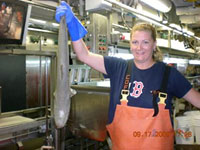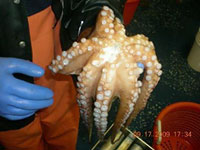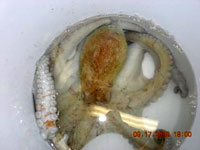

 | |||||||||||||||
|
|
Journals 2009/2010Beth Brocato
September 18, 2009 The rough seas have returned. Waves up to 10 feet have been recorded. It is very difficult to take a shower when the boat is rocking. I also felt as if I might roll out of my sleeping bunk at any moment. We are still sampling many of the southernmost stations. This is very exciting to the scientists on board because we are getting such a large diversity of fish in each catch. Even though the catches are not large, it takes a long time to identify, sort and catalogue. Some of the fish are unknown to the scientists so they have to take their best guess. The unknown species are frozen and will be taken back to the lab to positively identify.
In addition we caught dozens of lion fish. We were told not to handle these fish as they have dangerous neurotoxins at the end of their barbed fins. The scientists were kind of baffled, because they usually don't catch this many lion fish. Last year they caught four and the year before only one. The chief scientist explained that this is not good news. Lion fish are an introduced species that have no natural enemies and yet they make a mess out of the already diminishing coral reefs.
We are still catching sharks. And our last catch of the day yielded two giant stingrays. These are similar to the rays that killed Steve Irwin, The Crocodile Hunter. The larger of the two stingrays weighed 200 kilograms! The stingrays are dangerous because their long tails (about 3 feet long) have a barbed spike that can really injure a person if the tail is whipped. The scientists took great care to measure and weigh the rays before releasing them back into the ocean.   |
||||||||||||||


